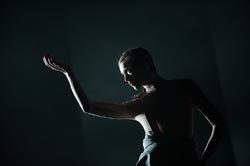
By Janice Steinberg

 LOS ANGELES — Along with the breakthroughs coming out of the Israeli tech industry, there’s another arena in which Israelis are breaking remarkable ground: contemporary dance. At last year’s International Exposure Dance Festival in Tel Aviv, I saw work from some 40 companies, from the still-vibrant grandmothers of modern dance in Israel—Batsheva and the Kibbutz Contemporary Dance Company—to a flock of daring newcomers.
LOS ANGELES — Along with the breakthroughs coming out of the Israeli tech industry, there’s another arena in which Israelis are breaking remarkable ground: contemporary dance. At last year’s International Exposure Dance Festival in Tel Aviv, I saw work from some 40 companies, from the still-vibrant grandmothers of modern dance in Israel—Batsheva and the Kibbutz Contemporary Dance Company—to a flock of daring newcomers.
One of the most vivid moments of the festival occurred one evening close to midnight, when a work in progress was shown in a small studio, the room buzzing with excitement. The work was “House.” The young (founded in 2006) troupe was L-E-V, named for the last initials of its collaborating artists, sound artist Ori Lichtik and choreographers Sharon Eyal and Gai Behar (interestingly, “lev” also translates as heart). And the dance … I almost wanted to touch the dancers to make sure they were human, because the movement style—distorted, weird, unpretty but beautiful—seemed to reinvent the body.
That illusion of the dancers being something other or more than human persisted when I saw “House” at the Redcat Theater in Los Angeles on Saturday. The buzz was just as intense, too—the theater was sold out.
“House” is disquieting, in the best sense of the word. Of the three L-E-V partners, only Eyal—who performed and choreographed for Batsheva—is a dancer. Lichtik and Behar both come from Tel Aviv’s nightlife scene. For “House,” Lichtik, who’s a musician and DJ, worked with the dancers to develop a basic structure, but within that structure, each performance—both sound and movement—is improvised.
The vibe is like walking into a club with throbbing house music, lighting that looks as if it’s thick with cigarette haze, and patrons—four men and three women—who are Gumbies, an impression intensified by unitards made of some reflective fabric. (Avi Yona Bueno did the lights, and the costumes are by Ma’ayan Goldman).
Movements squeeze through the dancers’ bodies like toothpaste in a tube; it’s a style at which Eyal, who’s one of the seven dancers, is a fluid master. Lower backs hyper-extend. Wide-stanced pliés descend so deeply that you could draw a straight line from one inner knee to the other. Rebecca Hytting does a leg extension that becomes a standing split, her up leg held in place by one of the men; oh, and she does this wearing high-heeled platform shoes.
To a heavy, sometimes assaultive beat, bodies cluster and even touch, but blank gazes suggest they’re barely aware of one another. A man stands behind Hytting, both of them in deep pliés, and repeatedly thrusts his fist at her crotch—and is it a sexual connection or an act of violence, or merely a random encounter between two twitchy clubbers? The one exception to the group’s vacant demeanor is Keren Lurie Pardes, who has so much animation in her face that I suspect she isn’t capable of going fully deadpan.
Toward the end, the mood lightens up a bit with some partner dancing to more melodic music, but “House” still feels like a place where you have to check your humanity at the door.
The dancers are riveting, and mix of music and movement, on Saturday night, so coherent that I’m still shaking my head over the idea that any of it was improvised. “House” is visceral, primal, thrilling.
*
Steinberg is a freelance writer who specializes in coverage of the arts and literature. She may be contacted via janice.steinberg@sdjewishworld.com